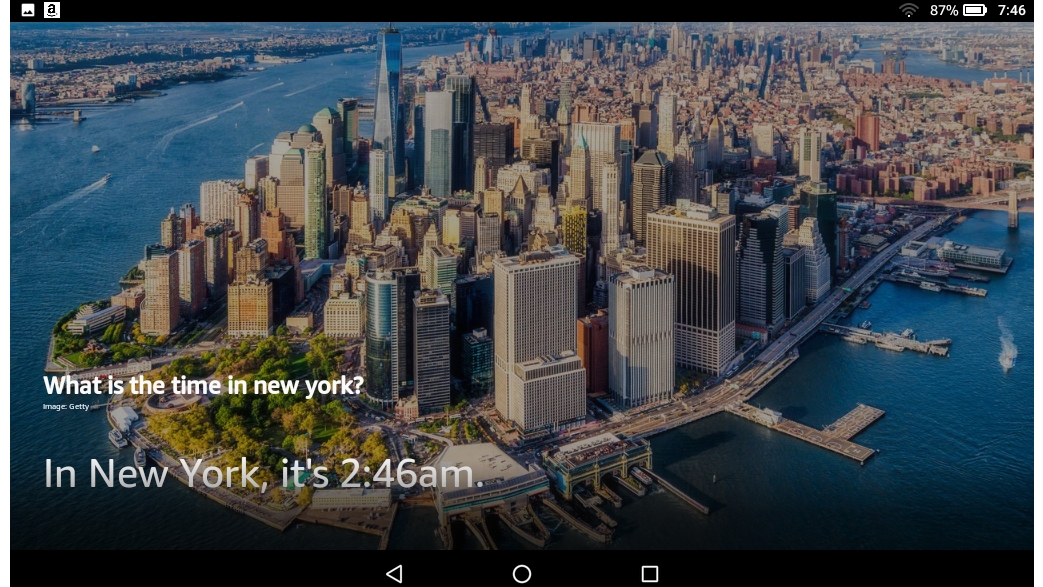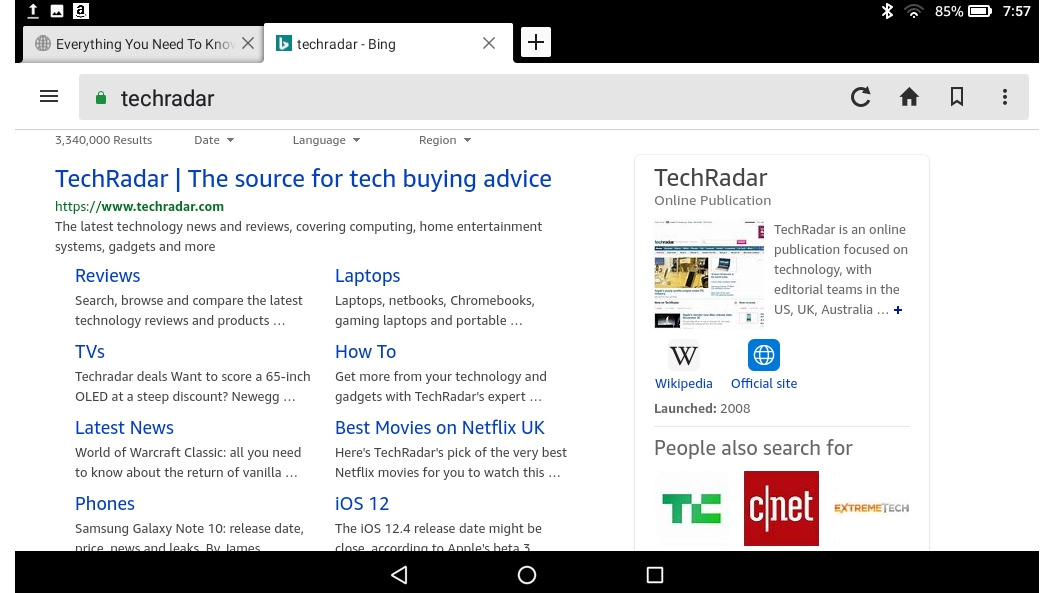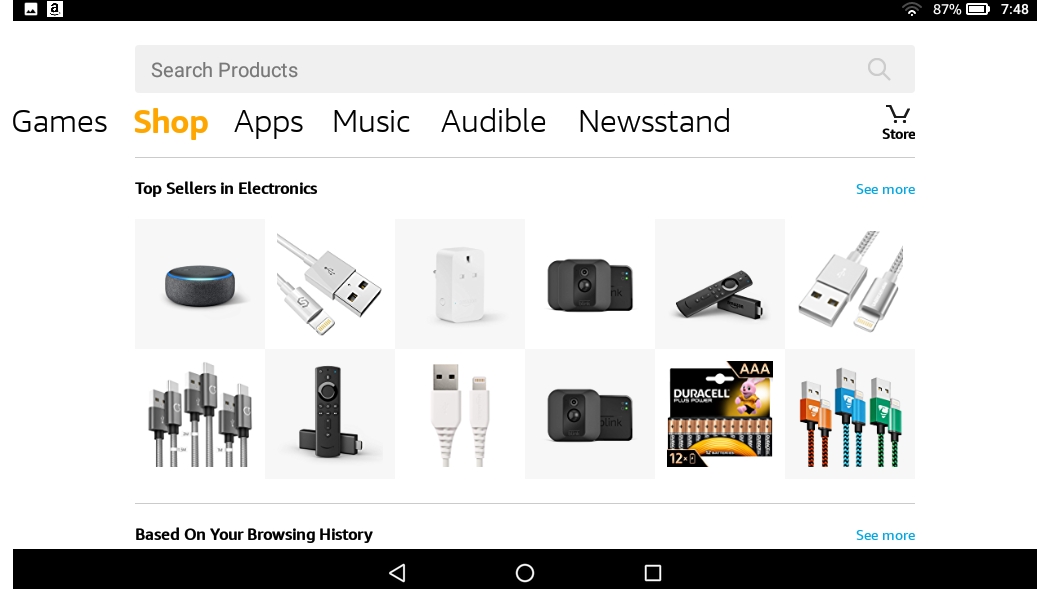Why you can trust TechRadar
Software
- Alexa works well but hands-free mode is limited
- Sluggish interface
The biggest difference between the Amazon Fire 7 (2019) and the Amazon Fire 7 (2017) comes in the form of Alexa. That’s because Amazon has bundled a hands-free version of its virtual assistant on this model, essentially turning it into a more functional version of the Amazon Echo Show.
But an Amazon Echo it’s not; the microphones are far from sensitive enough to use the feature from a distance, limiting the usefulness of hands-free mode.
If you can get over having to hold - or at least be next to - the Amazon Fire 7 (2019) to take advantage of the so-called hands-free mode, it’s level with the Echo Show from a functional standpoint.
You can mumble all sorts of commands its way, including asking it to search the internet, sift through your linked accounts for contextual information (like a calendar event), and even order products straight from Amazon.

Seeing as the Amazon Fire 7 (2019) isn’t a native Echo device, Alexa takes a backseat when it’s being used in a room that’s decked out with an Amazon Echo, Amazon Echo Dot, Amazon Echo Plus, Amazon Echo Show or Amazon Echo Spot.
As soon as you enter such a room, any command thrown the assistant’s way will be automatically handed off to the Echo, instead of being picked up by the tablet.
All in all, Alexa works well on the Fire 7 (2019), but it isn’t without its limitations and they all come back to the software itself, which is sluggish at best.
Sign up for breaking news, reviews, opinion, top tech deals, and more.
Applications take what feels like an eternity to load, then struggle to maintain a consistent pace while being used – there’s some brief latency when scrolling in Amazon Silk or browsing the Amazon App Store, for example.

That being said, the Fire 7 isn’t entirely unusable. Just align your expectations accordingly and you won't be disappointed. That means, don’t expect to be bouncing between multiple applications while streaming a movie from Amazon Prime Video.
You’ll need to do one thing at a time, but at $50/£50 that’s to be expected. This is not a high-end, lean, mean multi-tasking machine (think: iPad).
While based on Android, Amazon’s Fire OS is somewhat restricted, functioning as a hub for all of the firm’s different services – be it the Kindle Store, Prime Video, or even the retail side of the operation, it’s all accessible right from scrollable sections on the home screen.
Keen to maintain control, the Play Store has also been scrapped altogether, in favor of the firm’s more limited Amazon App Store.

Performance and benchmarks
- Generally poor performance and benchmarks
- No good for gaming
- Video and ebooks perform reasonably well
Armed with a 1.32GHz MediaTek MT8163 quad-core chipset and 1GB of RAM, the Amazon Fire 7 (2019) is a slouch when it comes to just about everything – and that’s reflected in the benchmark results.
When run through Geekbench, the tablet scored 646 in the single-core and 1,844 in the multi-core test. That’s a considerable amount less than the Amazon Fire HD 10 (2017), which achieved 1,204 and 3,305, respectively. That said, it is an improvement on the previous Fire 7.
What does that translate to in the real world? Well, in short, it means the CPU and RAM combination doesn’t pack the punch you might be used to if you own a modern flagship smartphone, like the iPhone XS – a handset that lingers near the top of Geekbench’s table with a single-core score of 4,821 and a multi-core result of 11,610. So expect the iPhone to be a lot faster and smoother.
After taking that into account, it’s no surprise the Fire 7 (2019) feels a little bit… delayed. It takes around four seconds for an application to open and be completely usable, which feels like a lifetime when compared to most low-end smartphones, let alone a high-end one.
Scrolling through Amazon’s Silk browser doesn’t come without its challenges, either – there’s some noticeable latency there.
The one thing the Fire 7 (2019) does excel at, however, is Kindle-ing. Flipping through pages is fast, with the slate taking no more than a second to flick the sheet over and display the fresh text.
The same can be said for streaming, provided you aren’t bouncing between multiple applications. If you leave Prime Video, Netflix or YouTube open without fumbling around, playback is cool, calm and collected.

Gaming could be a lot better for two main reasons. Firstly, the hardware doesn’t have enough oomph to drive some of the most demanding titles out there, like Asphalt 9: Legends, resulting in regular stuttering as the slate has to take a moment to catch its breath.
Secondly, the Amazon App Store isn’t home to anywhere near as many games as the Google Play Store, so your selection is extremely limited.
The latter is something that will change over time as more and more developers port their latest games to Amazon. However, the lack of processing power required to run them is something that will stick with the Amazon Fire 7 (2019) until its dying day.
As a result, we’d recommend taking a different route if having the option to kill time with an engaging title, such as Fortnite, is what you’re after.
